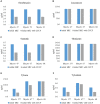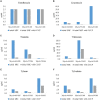Phenotypic and genetic insights into efflux pump mechanism in Mycoplasma anserisalpingitidis
- PMID: 37502405
- PMCID: PMC10371760
- DOI: 10.3389/fmicb.2023.1216893
Phenotypic and genetic insights into efflux pump mechanism in Mycoplasma anserisalpingitidis
Abstract
Introduction: Mycoplasma anserisalpingitidis is one of the most important waterfowl-pathogenic mycoplasmas. Due to inadequate antibiotic treatment, many strains with high minimal inhibitory concentration (MIC) values for multiple drugs have been isolated lately. Decreased antibiotic susceptibility in several Mycoplasma species are known to be associated with mutations in topoisomerase and ribosomal genes, but other strategies such as active efflux pump mechanisms were also described. The scope of this study was the phenotypic and genetic characterization of the active efflux mechanism in M. anserisalpingitidis.
Methods: We measured the MIC values in the presence and absence of different efflux pump inhibitors (EPIs), such as carbonyl cyanide m-chlorophenylhydrazine (CCCP), orthovanadate (OV), and reserpine (RSP). Moreover, bioinformatic tools were utilized to detect putative regulatory sequences of membrane transport proteins coding genes, while comparative genome analysis was performed to reveal potential markers of antibiotic resistance.
Results: Out of the three examined EPIs, CCCP decreased the MICs at least two-fold below the original MICs (in 23 cases out of 36 strains). In the presence of OV or RSP, MIC value differences could be seen only if modified dilution series (10% decrease steps were used instead of two-fold dilutions) were applied (in 24/36 cases with OV and 9/36 with RSP). During comparative genome analysis, non-synonymous single nucleotide polymorphisms (nsSNPs) were identified in genes encoding ABC membrane transport proteins, which were displayed in higher percentages in M. anserisalpingitidis strains with increased MICs. In terms of other genes, a nsSNP was identified in DNA gyrase subunit A (gyrA) gene which can be related to decreased susceptibility to enrofloxacin. The present study is the first to highlight the importance of efflux pump mechanisms in M. anserisalpingitidis.
Discussion: Considering the observed effects of the EPI CCCP against this bacterium, it can be assumed, that the use of EPIs would increase the efficiency of targeted antibiotic therapy in the future control of this pathogen. However, further research is required to obtain a more comprehensive understanding of efflux pump mechanism in this bacterium.
Keywords: ABC efflux pump; Mycoplasma sp. 1220; antimicrobial resistance; efflux pump inhibitors; minimal inhibitory concentration.
Copyright © 2023 Nagy, Kovács, Wehmann, Bekő, Földi, Bányai, Kreizinger and Gyuranecz.
Conflict of interest statement
The authors declare that the research was conducted in the absence of any commercial or financial relationships that could be construed as a potential conflict of interest.
Figures



Similar articles
-
Identification and detection of mutations potentially associated with decreased susceptibility to macrolides and lincomycin in Mycoplasma anserisalpingitidis isolates.Vet Microbiol. 2022 Mar;266:109362. doi: 10.1016/j.vetmic.2022.109362. Epub 2022 Jan 31. Vet Microbiol. 2022. PMID: 35144043
-
[Effects of four efflux pump inhibitors on the activities of clarithromycin against Mycobacterium abscessus].Zhonghua Jie He He Hu Xi Za Zhi. 2022 May 12;45(5):468-474. doi: 10.3760/cma.j.cn112147-20210923-00669. Zhonghua Jie He He Hu Xi Za Zhi. 2022. PMID: 35527462 Chinese.
-
Whole Genome Analysis Reveals New Insights into Macrolide Resistance in Mycoplasma pneumoniae.Biomed Environ Sci. 2017 May;30(5):343-350. doi: 10.3967/bes2017.045. Biomed Environ Sci. 2017. PMID: 28549490
-
[The importance of efflux systems in antibiotic resistance and efflux pump inhibitors in the management of resistance].Mikrobiyol Bul. 2015 Apr;49(2):278-91. doi: 10.5578/mb.8964. Mikrobiyol Bul. 2015. PMID: 26167829 Review. Turkish.
-
Mechanisms of fluoroquinolone resistance: an update 1994-1998.Drugs. 1999;58 Suppl 2:11-8. doi: 10.2165/00003495-199958002-00003. Drugs. 1999. PMID: 10553699 Review.
References
-
- Bai B., Chen C., Zhao Y., Xu G., Yu Z., Tam V. H., et al. (2022). In vitro activity of tigecycline and proteomic analysis of tigecycline adaptation strategies in clinical Enterococcus faecalis isolates from China. J. Glob. Antimicrob. Resist. 30, 66–74. doi: 10.1016/j.jgar.2022.04.022, PMID: - DOI - PubMed
LinkOut - more resources
Full Text Sources
Molecular Biology Databases

